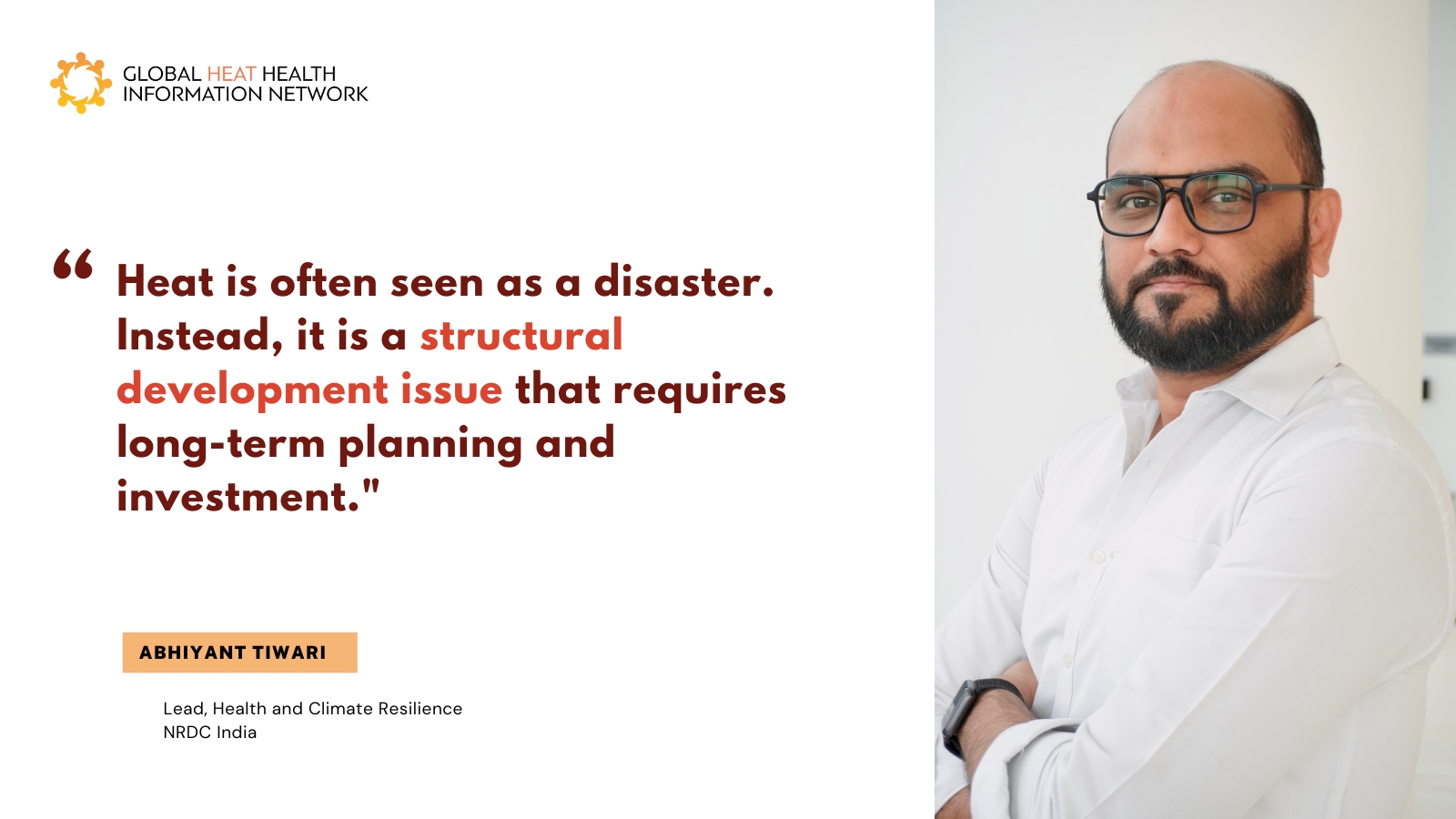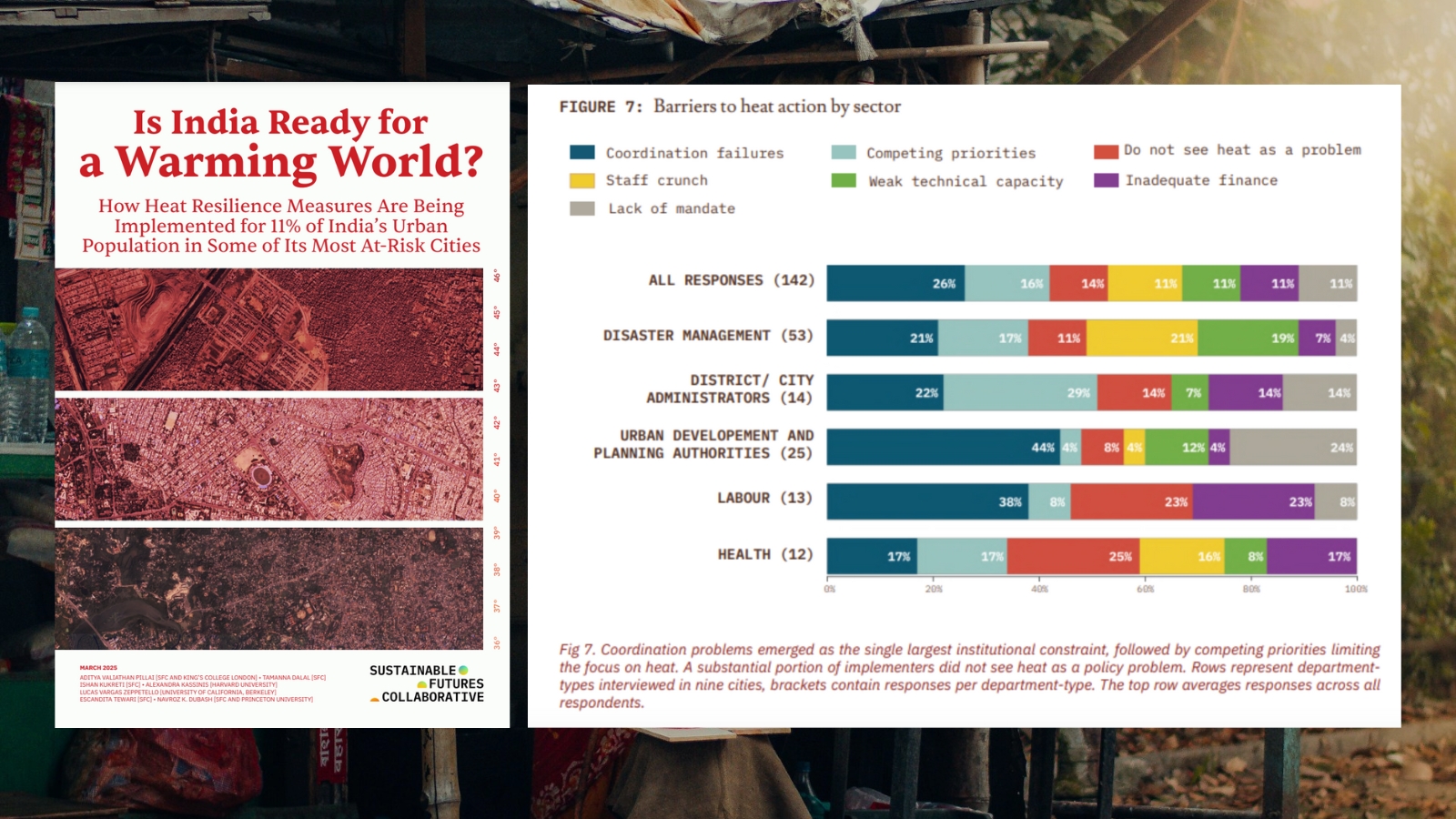Innovating Heat Resilience: Lessons from India for a Warming World
Published: April 7, 2025
…
As temperatures continue to rise in India and around the world, local innovations, cutting-edge research, and strong partnerships are transforming how South Asia is preparing for extreme heat. From mapping urban heat hotspots to reimagining how we keep indoor spaces cool, India is emerging as a leader in forging a heat resilient future.
Recently in New Delhi, the Global Heat Health Information Network (GHHIN) joined the conversations at the 2025 Global Heat & Cooling Forum and the India 2047 Forum— two major events that brought together policymakers, scientists, practitioners, and community leaders from across India and the world, to have sometimes difficult conversations and advance solutions for sustainable cooling and extreme heat risks.
India’s leadership in piloting locally relevant solutions was front and center, highlighting a growing movement of innovation. The discussions reinforced the power of community-led action, evidence-based policies, and challenged us to rethink building and systems design —not just for cooling, but for creating spaces and communities that truly support well-being in a warming world.

2025 Global Heat & Cooling Forum
17-18 March 2025
Hosts: NRDC India, the Indian National Disaster Management Authority (NDMA), the Department of Science and Technology (DST), and The World Bank Group
Extreme heat is one of the deadliest climate threats, yet access to cooling remains out of reach for billions. The 2025 Global Heat & Cooling Forum convened key stakeholders to drive forward climate-resilient cooling solutions and heat mitigation strategies, emphasizing the need for urgent, integrated solutions that protect lives while reducing emissions.
The Forum explored the complex links between heat and cooling, emphasizing how conventional short-term solutions like air conditioning can worsen long-term climate challenges. As temperatures continue to rise globally, energy-efficient and climate-smart cooling have never been more urgently needed.
A recurring theme raised throughout the event was the need to rethink heat risk governance. We need to move away from treating heat as a short-term emergency, and towards embedding Heat Action Plans into long-term planning frameworks across public health, disaster risk management, and urban development. Cities like Mumbai are already leading the way in this shift.
Experts agreed that multi-sectoral collaboration—spanning energy, health, urban planning, and finance—is essential to address heat holistically. To scale solutions that work, we need innovative financing mechanisms, such as climate insurance, microfinance, and public-private partnerships, as well as regulatory incentives to mobilize private sector action. Localized, data-driven forecasting is also essential to creating tailored responses and improving early warning systems.
Throughout the event, discussions were framed through an equity lens. Extreme heat disproportionately impacts vulnerable communities, particularly low-income residents, informal workers, and women, and closing this “heat divide” requires community-led adaptation strategies and inclusive, gender-sensitive policies.
Key Takeaways
- Heat and Cooling Are Intertwined Challenges
Rising temperatures increase cooling demand, but air conditioning worsens climate change; experts call for energy-efficient cooling and better urban planning. - Rethinking Climate Governance
Cities need to shift from treating heat as a short-term issue to institutionalizing heat action plans in long-term planning frameworks. - Equity and Inclusion in Heat Resilience
Extreme heat disproportionately impacts vulnerable groups, calling for stronger worker protections and gender-sensitive, community-led adaptation. - Solutions must be multi-sectoral
Collaboration across urban planning, energy, health, and finance is vital to scaling sustainable cooling and heat resilience. - Financing and Innovation
Better funding mechanisms, including public-private partnerships and climate-smart insurance, are needed to scale heat resilience efforts. - Better Data, Better Solutions
Localized strategies using high-resolution climate data and integrated forecasting can improve early warning systems and policy making.
Head of the WHO-WMO Joint Office for Climate and Health and Global Heat Health Information Network (GHHIN) co-lead, Joy Shumake-Guillemot delivered an urgent message:
The science is clear. Extreme heat threatens health, economies, infrastructure, and the ecosystems that sustain us—but proven solutions exist, and by scaling them now, we can close the implementation gap, protect communities, and build a climate-resilient future before it’s too late.
She stressed that too many current heat response and cooling interventions focus on short-term fixes, while long-term strategies are often sidelined due to governance hurdles and competing priorities. To truly build resilience, we must commit to sustained, systemic change.

Abhiyant Tiwari, Lead for Health and Climate Resilience at NRDC India and a GHHIN Management Committee member, argued that to protect communities, we must shift from reactive measures to proactive, long-term strategies that integrate heat resilience into urban planning, health systems, and infrastructure development.

India 2047: Building a Climate-Resilient Future
19-22 March 2025
Hosts: The Lakshmi Mittal and Family South Asia Institute at Harvard University and India’s Ministry of Environment, Forests & Climate Change
The India 2047 Forum explored how South Asia can thrive as India faces unprecedented climate challenges. Scientists stressed that future warming will be faster and more intense, with extreme weather becoming more unpredictable. While weather and climate forecasting and predictions are improving, early action remains crucial.
Over four days, experts discussed pressing issues, shared groundbreaking research, and offered new perspectives on health, labor, urban planning, and the impacts of climate change on water and agriculture. A key focus was making weather and climate forecasting and predictions more useful for decision-making across sectors—from farming to urban design. The need for action based on available data was emphasized, even as systems to track heat-related health risks continue to evolve.
The Forum brought attention to the challenges faced by India’s workers, many of whom are already adapting informally to rising heat but need stronger protections and legal recognition. In urban planning, experts stressed that infrastructure must go beyond cooling, focusing on long-term livability, equity, and resilience. A key debate emerged: is heat a disaster or an ongoing development issue? This distinction will shape future policies and investments.
The event demonstrated that scientific innovation, community-driven projects, and entrepreneurial startups are already making South Asia more heat-resilient. But scaling these efforts requires sustained investment and systemic change. From heat-adaptive housing to scalable startup solutions, experts agreed that science and technology must be backed by greater investment to create lasting, large-scale impact.
Aligned with GHHINs ongoing priority to support heat action planning and heat risk governance was a panel discussion on India’s leadership in deploying Heat Action Planning at city, state, and national levels. Moderated by Aditya Pillai lead author of a new report from the Sustainable Futures Collaborative that examines how Indian cities are implementing heat policies. The report assesses the experience in India and highlights the need for long-term preparedness and improved coordination and governance.
 Sustainable Futures Collective (2025).Is India Ready for a Warming World? How Heat Resilience Measures Are Being Implemented for 11% of India’s Urban Population in Some of Its Most At-Risk Cities
Sustainable Futures Collective (2025).Is India Ready for a Warming World? How Heat Resilience Measures Are Being Implemented for 11% of India’s Urban Population in Some of Its Most At-Risk Cities
During the session, Sameer Kwatra (NRDC India) pointed to cities like Ahmedabad and Jodhpur as pioneers in heat action planning, demonstrating the power of public-private partnerships in scaling solutions. Arunabha Ghosh (Council on Energy, Environment and Water) stressed the need for hyper-local data to guide early warning systems and policy. Siddharth Nadkarny (Atkins Realis) introduced the upcoming Heat Action Handbook (developed with the Red Cross Climate Center for the World Bank), emphasizing a simple but urgent principle: start now, start small.
Alejandro Saez Reale, Technical Support Unit Coordinator for GHHIN at the World Meteorological Organization, introduced the Network’s mission and its role in bridging science and policy to support heat risk governance and action planning. He underscored the Network’s three core goals—connecting experts, accelerating knowledge, and catalyzing action—to ensure that decision-makers have access to the best available research to drive effective, scalable heat resilience strategies. He noted that the challenges experienced in India are not unique, but reported as common barriers in many countries also working to establish heat risk governance
Key Takeaways
- Forecasting for early action: There is an urgent need to make weather and climate forecasting and predictions more useful for real-world decisions—whether for farmers, urban planners, or workers. Adaptation strategies must be tailored to their specific needs to be effective.
- Health: Data on heat-related risks is improving, but gaps remain. Governments should act on what’s already known while working toward better, more detailed tracking.
- Workers: Many are already adapting, but stronger protections and policy engagement are needed, especially in informal sectors.
- Urban Planning & Infrastructure: Infrastructure must go beyond cooling solutions to prioritize long-term livability and resilience.
- Defining Heat Risks: A critical question emerged—should extreme heat be treated as a disaster or a daily challenge? The answer will shape future policy and investment.
Looking Ahead
Throughout both Forums, one theme stood out—collaboration and cooperation is essential. Climate challenges cut across sectors, and addressing them requires a long-term, coordinated effort between actors from community to national levels. The ideas and innovations shared here are just the beginning; scaling them up will be key, not just for India, but for the world.
Without strong leadership, forward-thinking planning, and collaboration across sectors, sustainable heat risk reduction won’t scale fast enough to meet the growing challenge of extreme heat. We already have solutions. Now is the time to move beyond small, incremental changes and fundamentally rethink how we design, build, and plan for thriving communities in a rapidly warming world.India’s expanding network of local innovation, research, and partnerships is demonstrating what’s possible—not just for the country, but for the world.
These discussions reinforced the urgency of working together to address extreme heat. As we move forward, The Global Heat Health Information Network invites partners from around the world to join us in this critical mission, as we scale up our Network presence in the South Asia region.
Event coverage and resources:
- NRDC Expert Blog: Global Heat & Cooling Forum: Solutions for a Warming World
- India 2047: Key Learnings Summarized by the Scientific Committee
- Climateverse: Driving data driven responses to climate change in South Asia
- Is India Ready for a Warming World? How Heat Resilience Measures Are Being Implemented for 11% of India’s Urban Population in Some of Its Most At-Risk Cities
- The Future of Cooling Programme